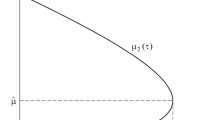Abstract
The existence of a family of bounded soliton solutions for a finite-difference analogue of the wave equation with a general nonlinear potential is proved. The proof is based on a formalism establishing a one-to-one correspondence between soliton solutions of an infinite-dimensional dynamical system and solutions of a family of functional differential equations of the pointwise type. A key point in the proof of the existence of bounded soliton solutions is a theorem on the existence and uniqueness of soliton solutions in the case of a quasilinear potential. Another important circumstance for the considered class of systems of equations is that they have a number of symmetries due to the low dimension (one-dimensionality) of the space at each lattice point.




Similar content being viewed by others
REFERENCES
M. Toda, Theory of Nonlinear Lattices (Springer-Verlag, Heidelberg, 1981). https://doi.org/10.1007/978-3-642-83219-2
T. Miwa, M. Jimbo, and E. Date, Solitons: Differential Equations, Symmetries, and Infinite-Dimensional Algebras (Cambridge Univ. Press, Cambridge, 2000).
Ya. I. Frenkel and T. A. Contorova, “On the theory of plastic deformation and twinning,” J. Exp. Theor. Phys. 8 (1), 89–95 (1938).
L. D. Pustyl’nikov, “Infinite-dimensional non-linear ordinary differential equations and the KAM theory,” Russ. Math. Surv. 52 (3), 551–604 (1997). https://doi.org/10.1070/RM1997v052n03ABEH001810
L. A. Beklaryan, “A boundary value problem for a differential equation with deviating argument,” Dokl. Akad. Nauk SSSR 291 (1), 19–22 (1986).
L. A. Beklaryan, “Differential equation with deviating argument as an infinite-dimensional dynamical system,” Reports on Applied Mathematics (Vychisl. Tsentr Akad. Nauk SSSR, Moscow, 1989) [in Russian].
L. A. Beklaryan, “Introduction to the theory of functional differential equations and their applications: Group approach,” J. Math. Sci. 13, 2813–2954 (2006). https://doi.org/10.1007/s10958-006-0145-3
L. A. Beklaryan, Introduction to the Theory of Functional Differential Equations: Group Approach (Factorial, Moscow, 2007) [in Russian].
J. P. Keener, “Propagation and its failure in coupled systems of discrete excitable cells,” SIAM J. Appl. Math. 47 (3), 556–572 (1987). https://doi.org/10.1137/0147038
B. Zinner, “Existence of traveling wavefront solutions for the discrete Nagumo equation,” J. Differ. Equations 96, 1–27 (1992). https://doi.org/10.1016/0022-0396(92)90142-A
J. Maller-Paret, “The global structure of traveling waves in spatially discrete dynamical systems,” J. Dyn. Differ. Equations 11, 49–127 (1999). https://doi.org/10.1023/A:1021841618074
J. W. Cahn, J. Mallet-Paret, and E. S. Van Vleck, “Traveling wave solutions for systems of ODEs on a two-dimensional spatial lattice,” SIAM J. Appl. Math. 59, 455–493 (1998). https://doi.org/10.1137/S0036139996312703
L. A. Beklaryan, “Quasitravelling waves,” Sb. Math. 201 (12), 1731–1775 (2010). https://doi.org/10.1070/SM2010v201n12ABEH004129
L. A. Beklaryan, “Quasi-travelling waves as a natural extension of the class of travelling waves,” Vestn. Tambov. Gos. Univ. 19 (2), 331–340 (2014).
L. A. Beklaryan, “A new approach to the question of the existence of bounded solutions of functional differential equations of point type,” Izv. Math. 84 (2), 209–245 (2020). https://doi.org/10.1070/IM8896
A. L. Beklaryan, “Numerical methods for constructing solutions of functional differential equations of pointwise type,” Adv. Syst. Sci. Appl. 20 (2), 56–70 (2020). https://doi.org/10.25728/assa.2020.20.2.878
A. L. Beklaryan and L. A. Beklaryan, “On the existence of periodic and bounded solutions for functional differential equations of pointwise type with a strongly nonlinear right-hand side,” Lobachevskii J. Math. 41 (11), 2136–2142 (2020). https://doi.org/10.1134/S1995080220110062
A. L. Beklaryan and L. A. Beklaryan, “Existence of bounded soliton solutions in the problem of longitudinal vibrations of an infinite elastic rod in a field with a strongly nonlinear potential,” Comput. Math. Math. Phys. 61 (12), 1980–1994 (2021). https://doi.org/10.31857/S0044466921120061
Funding
The work was supported by the Russian Foundation for Basic Research, project no. 19-01-00147.
Author information
Authors and Affiliations
Corresponding authors
Ethics declarations
The authors declare that they have no conflicts of interest.
Additional information
Translated by I. Ruzanova
Rights and permissions
About this article
Cite this article
Beklaryan, A.L., Beklaryan, L.A. Existence of Bounded Soliton Solutions in the Problem of Longitudinal Oscillations of an Elastic Infinite Rod in a Field with a Nonlinear Potential of General Form. Comput. Math. and Math. Phys. 62, 904–919 (2022). https://doi.org/10.1134/S0965542522060033
Received:
Revised:
Accepted:
Published:
Issue Date:
DOI: https://doi.org/10.1134/S0965542522060033




